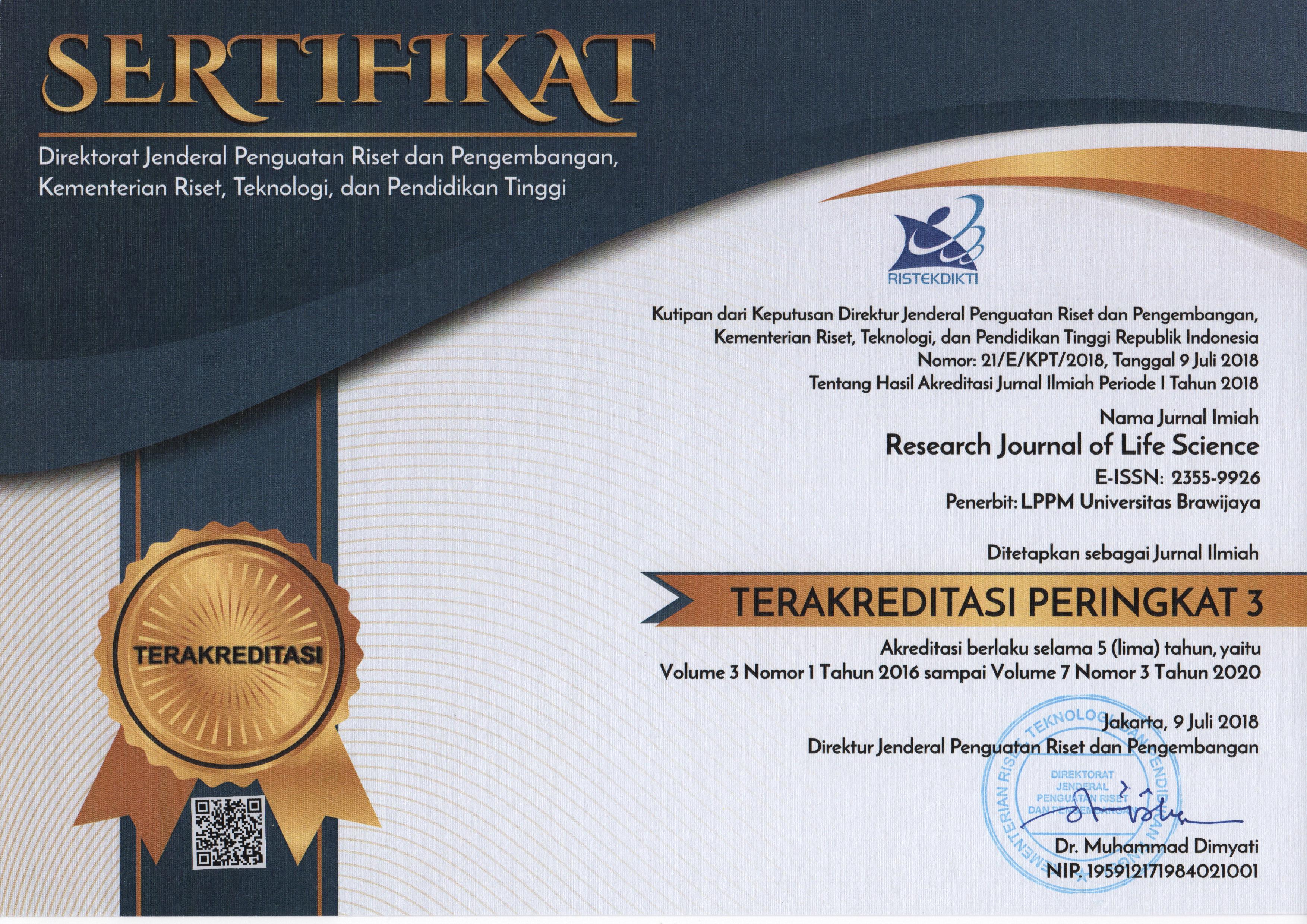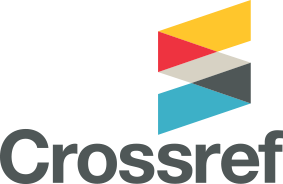Identification of Aflatoxigenic Fungi in Myristica fragrans using V8 and CAM Media
Abstract
Keywords
Full Text:
PDFReferences
Alcaide-Molina, M., Ruiz-Jiménez, J., Mata-Granados, J. M., & Luque de Castro, M. D. (2009). High through-put aflatoxin determination in plant material by automated solid-phase extraction on-line coupled to laser-induced fluorescence screening and determination by liquid chromatography–triple quadrupole mass spectrometry. Journal of Chromatography A, 1216(7), 1115–1125. https://doi.org/10.1016/j.chroma.2008.12.049
Baquião, A. C., de Oliveira, M. M. M., Reis, T. A., Zorzete, P., Diniz Atayde, D., & Correa, B. (2013). Polyphasic approach to the identification of Aspergillus section Flavi isolated from Brazil nuts. Food Chemistry, 139(1–4), 1127–1132. https://doi.org/10.1016/j.foodchem.2013.01.007
Barnett, H. L., & Hunter, B. B. (1998). llustrated Genera of Imperfect Fungi (4th Edition). APS Press.
Chang, P.-K., & Hua, S.-S. T. (2007). Molasses supplementation promotes conidiation but suppresses aflatoxin production by small sclerotial Aspergillus flavus. Letters in Applied Microbiology, 44(2), 131–137. https://doi.org/10.1111/j.1472-765X.2006.02056.x
Cucci, C., Mignani, A. G., Dall’Asta, C., Pela, R., & Dossena, A. (2007). A portable fluorometer for the rapid screening of M1 aflatoxin. Sensors and Actuators B: Chemical, 126(2), 467–472. https://doi.org/10.1016/j.snb.2007.03.036
Davis, N. D., Iyer, S. K., & Diener, U. L. (1987). Improved method of screening for aflatoxin with a coconut agar medium. Applied and Environmental Microbiology, 53(7), 1593–1595. https://doi.org/10.1128/aem.53.7.1593-1595.1987
Faulkner, A. G. 2014. Aflatoxins: food sources, occurrence and toxicological effects. Nova Publishers.
Febbiyanti, T. R., Wiyono, S., Yahya, S., & Widodo. (2018). Lasiodiplodia theobromae fungus causing stem canker disease on rubber tree (Hevea brasiliensis) in Indonesia. Journal of Agronomy, 18(1), 41–48. https://doi.org/10.3923/ja.2019.41.48
Fente, C. A., Ordaz, J. J., Vázquez, B. I., Franco, C. M., & Cepeda, A. (2001). New Additive for Culture Media for Rapid Identification of Aflatoxin-Producing Aspergillus Strains. Applied and Environmental Microbiology, 67(10), 4858–4862. https://doi.org/10.1128/AEM.67.10.4858-4862.2001
Frisvad, J. C., Hubka, V., Ezekiel, C. N., Hong, S. B., Nováková, A., Chen, A. J., Arzanlou, M., Larsen, T. O., Sklenář, F., Mahakarnchanakul, W., Samson, R. A., & Houbraken, J. (2019). Taxonomy of Aspergillus section Flavi and their production of aflatoxins, ochratoxins and other mycotoxins. Studies in Mycology, 93, 1–63. https://doi.org/10.1016/J.SIMYCO.2018.06.001
Henuk, J. B. D., Sinaga, M. S., & Hidayat, S. H. (2017). Morphological and molecular identificationof fungal pathogens causing gummosis disease of Citrus spp. in Indonesia. Biodiversitas Journal of Biological Diversity, 18(3), 1100–1108. https://doi.org/10.13057/biodiv/d180330
Khan, R., Mohamad Ghazali, F., Mahyudin, N. A., & Samsudin, N. I. P. (2020). Morphological Characterization and Determination of Aflatoxigenic and Non-Aflatoxigenic Aspergillus flavus Isolated from Sweet Corn Kernels and Soil in Malaysia. Agriculture, 10(10), 450. https://doi.org/10.3390/agriculture10100450
Klich, M. A. (2002). Identification of Common Aspergillus species. The Centraalbureau voor Schimmelcultures.
Kong, W.-J., Liu, S.-Y., Qiu, F., Xiao, X.-H., & Yang, M.-H. (2013). Simultaneous multi-mycotoxin determination in nutmeg by ultrasound-assisted solid–liquid extraction and immunoaffinity column clean-up coupled with liquid chromatography and on-line post-column photochemical derivatization-fluorescence detection. The Analyst, 138(9), 2729. https://doi.org/10.1039/c3an00059a
Kuete, V. (2017). Myristica fragrans: A Review. In Medicinal Spices and Vegetables from Africa (pp. 497–512). Elsevier. https://doi.org/10.1016/B978-0-12-809286-6.00023-6
Okayo, R. O., Andika, D. O., Dida, M. M., K’otuto, G. O., & Gichimu, B. M. (2020). Morphological and molecular characterization of toxigenic Aspergillus flavus from groundnut kernels in Kenya. International Journal of Microbiology, 2020. https://doi.org/10.1155/2020/8854718
Salman, A. B. A., Sudirman, L. I., & Nandika, D. (2020). Selection of stain fungi on rubberwood (Hevea brasiliensis) and its growth response against chitosan. Biodiversitas, 21(10), 4501–4508. https://doi.org/10.13057/biodiv/d211005
Samson, R. A., Visagie, C. M., Houbraken, J., Hong, S. B., Hubka, V., Klaassen, C. H. W., Perrone, G., Seifert, K. A., Susca, A., Tanney, J. B., Varga, J., Kocsubé, S., Szigeti, G., Yaguchi, T., & Frisvad, J. C. (2014). Phylogeny, identification and nomenclature of the genus Aspergillus. Studies in Mycology, 78(1), 141–173. https://doi.org/10.1016/j.simyco.2014.07.004
Sandra, F. K., Nurhasanah, Y. S., Mutaqin, K., Wiyono, S., & Tondok, E. T. (2021). Keragaman morfologi dan molekuler Lasiodiplodia theobromae dari tanaman jeruk, kakao, karet, manggis, dan pisang. Jurnal Fitopatologi Indonesia, 17(2), 58–66. https://doi.org/10.14692/jfi.17.2.58-66
Smeesters, L., Meulebroeck, W., Raeymaekers, S., & Thienpont, H. (2015). Optical detection of aflatoxins in maize using one- and two-photon induced fluorescence spectroscopy. Food Control, 51, 408–416. https://doi.org/10.1016/j.foodcont.2014.12.003
Susanna, S., Sinaga, M. S., Wiyono, S., & Triwidodo, H. (2020). Diagnosis of dieback disease of the nutmeg tree in Aceh Selatan, Indonesia. Walailak Journal of Science and Technology, 17(8), 801–810. https://doi.org/10.48048/wjst.2020.4379
Varga, J., Frisvad, J. C., & Samson, R. A. (2011). Two new aflatoxin producing species, and an overview of Aspergillus section Flavi. Studies in Mycology, 69, 57–80. https://doi.org/10.3114/sim.2011.69.05
Vazquez, M. L., Cepeda, A., Prognon, P., Mahuzier, G., & Blais, J. (1991). Cyclodextrins as modifiers of the luminescence characteristics of aflatoxins. Analytica Chimica Acta, 255(2), 343–350. https://doi.org/10.1016/0003-2670(91)80066-3
Wei, C.-I., Swartz, D. D., & Cornell, J. A. (1985). Effects of Culture Media, Exposure Time and Temperature on Near-Ultraviolet-Induced Sporulation of Alternaria alternata. Journal of Food Protection, 48(4), 316–319. https://doi.org/10.4315/0362-028X-48.4.316
DOI: https://doi.org/10.21776/ub.rjls.2022.009.03.3
Refbacks
- There are currently no refbacks.

This work is licensed under a Creative Commons Attribution-NonCommercial 4.0 International License.










